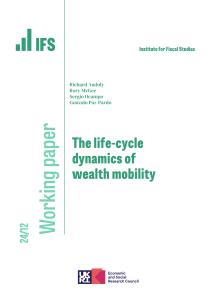Ed Miliband and Ed Balls today announced that a Labour Government would significantly reduce the generosity of the income tax treatment of private pensions. Those with incomes above £150,000 a year would only be able to receive income tax relief at a rate of 20% (rather than the 50% marginal rate of income tax they would face under Labour), the annual pension contribution limit would be reduced by a quarter from £40,000 to £30,000 and the lifetime limit would be cut by one-fifth from £1.25m to £1m. They estimate the resulting tax increase would be sufficient to cover the around £2.7 billion increase in borrowing that Labour estimates would otherwise arise from their proposed reforms to the financing of higher education in England, including a reduction in maximum tuition fees from £9,000 a year to £6,000 a year (the reforms are discussed here).
As discussed in last year’s Green Budget a desirable benchmark for pensions taxation is a system where full tax relief is given up-front, returns in a pension are left free of personal taxation and income is taxed in full on receipt. Unfortunately Labour’s proposed tax increase would move the system further away from this benchmark.
The policy to reduce the rate of income tax relief for those with an income of more than £150,000 a year appears similar to one proposed by the last Labour Government in its 2009 Budget. At that time, they proposed restricting tax relief on pension contributions to the basic rate (20%), but only for those with incomes above £130,000 and whose gross income plus employer pension contributions was above £150,000 (see here for a discussion). The way the policy was designed meant that some with large employer pension contributions would face a substantial increase in their income tax bill if their income rose from just under to just above the £130,000 threshold: For example an individual earning £129,000 plus an employer pension contribution of £40,000 would face an increase in their annual income tax bill of over £10,000 if their current wage were to rise to £130,000 (assuming a top rate of income tax of 50%).
The policy was dropped by the incoming coalition government in favour of a reduction to annual and lifetime allowances designed to raise the same amount of money. At the time the Labour policy was expected to raise £3.6 billion (from just 300,000 individuals, implying an average (mean) tax increase for these people of £12,000 per year). However, the reductions in annual and lifetime allowances that have occurred since mean that such a policy would now be expected to raise far less than this.
Fundamentally the idea that income tax relief should be restricted to the basic rate is misguided. The error stems from looking at the tax treatment of pension contributions in isolation from the tax treatment of the pension income they finance. Pension contributions are excluded from taxable income precisely because pension income is taxed when it is received: in effect, the tax due on earnings paid into a pension is deferred until the money (plus any returns earned in the interim) is withdrawn from the fund. The tax system should treat pension contributions and pension income in a symmetric way: it is hard to see why it should be unfair for those above £150,000 to get tax relief at their marginal rate, but not for other higher-rate taxpayers to do so. Indeed, these very-highest-income individuals are less likely to be only basic-rate taxpayers in retirement, removing one of the principal (although still not well-founded) arguments for restricting relief.
The other reforms proposed today – further restricting annual and lifetime limits – are less incoherent, although still not the best way to reduce the generosity of the pensions tax system. They would be in keeping with recent reforms, repeating what was done in the June 2010 Budget and the 2012 Autumn Statement. The government estimates that the reduction of the annual limit from £50,000 to £40,000 and the reduction of the lifetime limit from £1.5 million to £1.25 million implemented in April 2014 will together raise £1.1 billion in 2017–18 and more thereafter. Labour is proposing reductions of the same size, which should raise significantly more than £1.1 billion because far more people would be affected.
Reducing the annual allowance makes less sense than reducing the lifetime allowance. For a given level of lifetime contributions, it is not clear why we would want to penalise making occasional large contributions rather than frequent smaller contributions. In practical terms, reducing the annual allowance is more problematic, as valuing annual contributions to defined benefit pension schemes is difficult; the lower the annual limit, the more of these difficult valuations that must be done.
But the further you go down the route of cutting the lifetime limit, the more you move away from the relatively desirable system of taxation where full relief is given up-front, returns in a pension are left free of personal taxation and income is taxed in full on receipt. This would increase the risks that people will be incentivised to undersave for retirement and that more effort will be put into securing tax advantages by using more complex schemes.
If the system of pensions taxation is to be made less generous, then it would be better to tackle the two elements of the system that look generous relative to the aforementioned benchmark. First, up to one-quarter of an accumulated pension can be taken tax-free. This means that even under Labour’s proposed £1 million lifetime limit some could receive £250,000 that had escaped income tax altogether: it would be taxed neither when it was earned nor when it was withdrawn from the pension. Second, roughly three-quarters of pension contributions – those made by employers – escape National Insurance contributions (NICs) entirely. The official estimate of the cost of this NICs relief is a whopping £14 billion in 2013–14.
If Labour’s reforms are implemented, then – like the reforms to pensions taxation implemented by the current government – they would add further undesirable complexity and be a missed opportunity to rationalise those parts of the pensions tax system that are overly generous.









